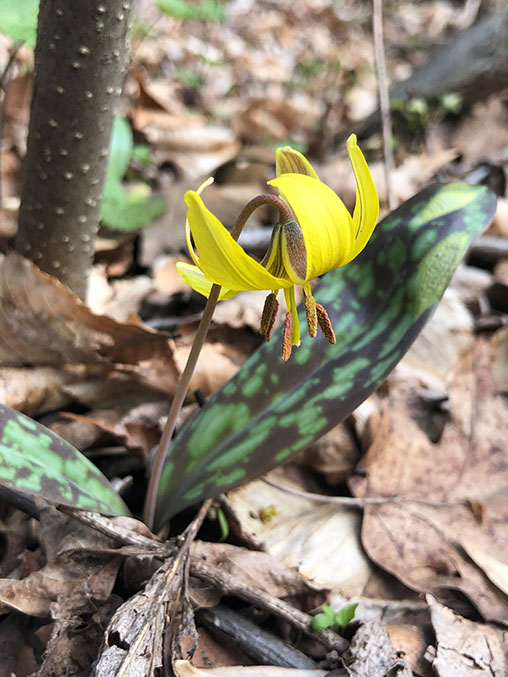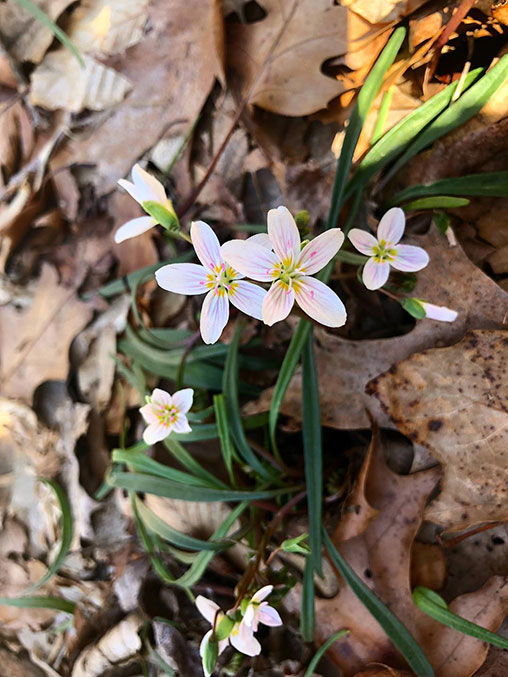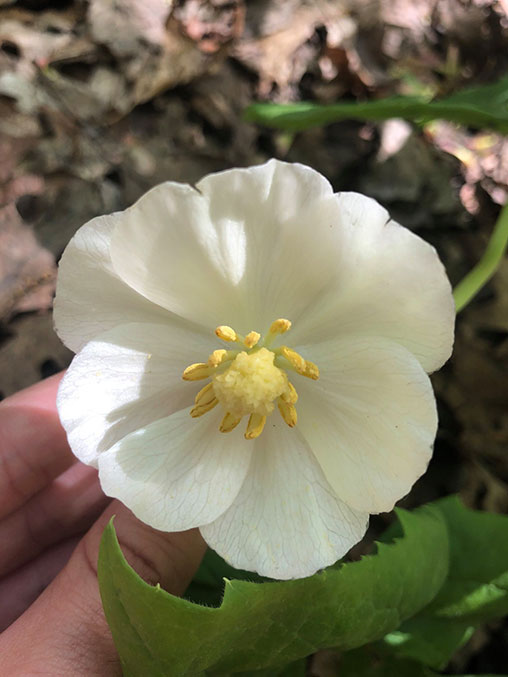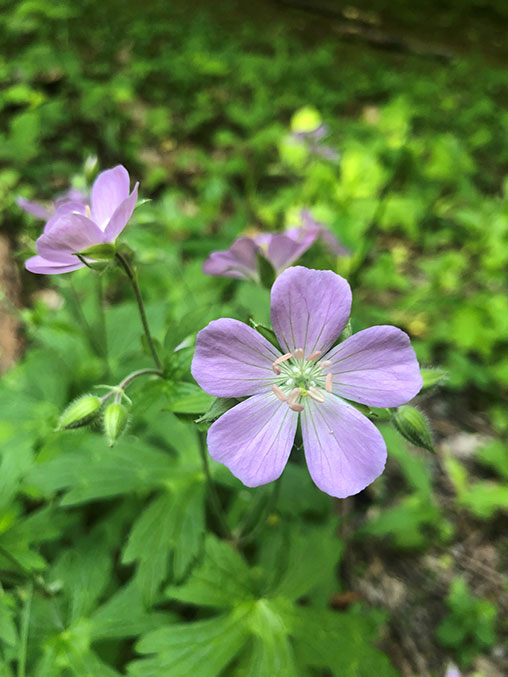Native Plants of New York City: Spring Ephemerals
As you walk through our woodland areas in springtime, just before the trees leaf out, you'll notice wildflowers growing on the forest floor. Some of these plants are called spring ephemerals! While spring brings us moments of beautiful blossoms in our landscaped parks through to summertime, these native wildflowers only appear for a short amount of time in the spring and play an important role in our forested ecosystems.
Spring ephemerals are perennial wildflowers that complete their aboveground lifecycle in the early spring. These plants must grow, flower, be pollinated, set seeds, and store energy within a few short weeks — all before the trees and shrubs leaf out and cast shade on the forest floor. In New York City, spring ephemerals bloom from approximately late March to early May. This period of time, between the late winter snowmelt and leaf emergence in the canopies of trees and shrubs, is perfect for spring ephemerals to have their moment in the sun. The weather and soil are warm and ample light reaches the forest floor to help them grow and bloom. As the trees leaf out and summer approaches, the plants finish their aboveground lifecycle, leaving only underground structures, such as bulbs and roots, for their next spring arrival.
Explore some of the spring ephemerals you'll encounter on your walk through the woods:
Yellow Trout Lily
Erythronium americanum, Liliaceae (lily family)
Bloom time: late March – mid-May
- Perennial herb that grows 4-10 inches tall
- A single nodding yellow flower with six petal-like structures called tepals that curve upward
- Two basal leaves mottled with brown and resemble markings of trout
- Immature plants with one leaf will not produce a flower
- Mature plants with two leaves will produce one flower
- May take 4-7 years to flower
- Forms large colonies of genetically identical individuals through the production of stolons - horizontal underground stems
- Colonies may be very long-lived (hundreds of years old!)
- Like other members of the lily family, it is a monocot – plants whose seeds contain a single embryonic leaf; have leaves with parallel veins; have flower parts arranged in multiples of three (6 tepals and 6 stamens)
Spring Beauty
Claytonia virginica, Montiaceae (miner's lettuce family)
Bloom time: mid-March – late May
- Perennial herb that grows 4-12 inches tall
- Smooth, fleshy, linear leaves
- Cluster of flowers with five petals that range in color from white to crimson
- Pink veins that run along the petals serve as nectar guides to direct pollinators to the nectar and pollen
- Each flower consists of both the stamens (male parts) and pistils (female parts)
- Flowers are protandrous – stamens (male parts) mature before pistils (female parts), ensuring that self-pollination does not occur
- Flowers open on warm, sunny days and close during cloudy or rainy days
- A solitary, mining bee, Andrena erigeniae (spring beauty miner bee) is a specialist pollinator of spring beauty
Dutchmans’ breeches
Dicentra cucullaria, Papaveraceae (poppy family)
Bloom time: late March – early May
- Perennial herb that grows 4-12 inches tall
- Clusters of white, pantaloon-shaped flowers along a nodding stem
- Each flower consists of two pairs of petals:
- Two outer petals that are long, spurred and white
- Two inner petals that are small, hooded, and yellow
- Nectar is stored at the tip of the elongated spur (pantaloons) which attracts pollinators with long proboscis such as bumblebees
- Leaves are basal, feathery and deeply-divided
- What's in a scientific name? For Dicentra cullaria, the origins of its name refer to the shape of the flower:
- “Dicentra” is Greek for “two-spurred” — "di” means two and “kentron” means spur
- "Cuculus" is Latin for "hood"
Bloodroot
Sanguinaria canadensis, Papaveraceae (poppy family)
Bloom time: mid-March – mid-April
- Perennial herb that grows 2-6 inches tall
- A single, white, waxy flower with 8-10 petals that will bloom for 1-2 days
- A single, kidney-shaped leaf with rounded lobes
- As it emerges, the single leaf encloses the flowering stalk to protect it from wind and help conserve warmth
- Cross-pollination is the primary reproductive method; however, this plant is capable of self-fertilization if not pollinated by bees or flies.
- It is a monotypic species – the only species in the genus "Sanguinaria"
- Like other members of the poppy family, it exudes a colored, milky sap. For bloodroot, this sap is red– giving it its common name.
Mayapple
Podophyllum peltatum, Berberidaceae (barberry family)
Bloom time: May
- Perennial herb that grows 1 – 1 ½ feet tall
- A single white flower that grows in the axil of two large umbrella-like leaves
- Produces a large, yellow fruit that is relished by eastern box turtle (primary seed dispersers)
- Plants exhibit both sexual and asexual reproduction
- Can form large colonies of genetically identical individuals through the production of rhizomes – horizontal underground stems
- Can be cross-pollinated by bumblebees and other long-tongued bees
- Plant is self-incompatible (does not self-pollinate). Plants must cross-pollinate with another genetically different individual for seed set to occur.
Wild Geranium
Geranium maculatum, Geraniaceae (geranium family)
Bloom time: mid-April – late May
- Perennial herb that grows 1 – 1 ½ feet tall
- Can grow in open, sunny sites such as meadows and roadsides, as well as moist woodlands
- Showy, five-petaled, pink to purple flowers with nectar guides
- Palmate, deeply lobed leaves with 5-6 lobes
- The nectar and pollen of the flowers attract bumblebees, mason bees, cuckoo bees, long-horned bees, Halictid bees, Andrenid bees, and others
- An Andrenid bee, Andrena distans, is a specialist pollinator of wild geranium
- Disperses seed by explosive dehiscence. The carpels of this fruit curl upward and backward to fling the seeds when ripe – expelling the seeds 10-30 feet away.
- Seeds are eaten by a variety of birds such as mourning doves, American robins, and dark-eyed Juncos
Best NYC Parks To Find Spring Ephemerals
Spring ephemerals naturally grow in our forested areas, and not typically in landscaped parks unless they were planted there. They thrive in nutrient-rich, moist undisturbed deciduous forests with shredded leaf litter, which is why some of our most natural parks are the perfect spots to find them.
Here are some of the parks our ecologists recommend for discovering spring ephemerals:
- Van Cortlandt Park in the Bronx
- Watch our tour of spring ephemerals in Van Cortlandt Park on Facebook!
- Central Park in Manhattan
- Prospect Park in Brooklyn
- The Greenbelt on Staten Island
- Cunningham Park in Queens
- Alley Pond Park in Queens
- Pelham Bay Park in the Bronx
How Spring Ephemerals Help Our Pollinators and Ants
Spring ephemerals are critical food sources for early-emerging pollinators, such as bumblebees, mining bees, gnats, and flies, as well as ants that live in and visit our parks. Spring ephemerals provide nectar and pollen to native bees and flies during a time when floral resources are scarce.
Most spring ephemerals have a mutually beneficial relationship with ants called myrmecochory. Most spring ephemerals produce seeds with elaiosomes, a fleshy, lipid-rich structure that is a nutritious food source for ants (primary seed dispensers). Ants will carry the seeds back to their nests, consume the elaiosomes and discard the seeds in their refuse piles. Both plants and ants benefit. The seeds are dispersed far away from the parent plant where they may find suitable habitat to germinate and the ants get a nutritious meal.
Primary Threat: Invasive Plants
The understory of some of our parks is overwhelmed with invasive species such as lesser celandine, garlic mustard (shown here), multiflora rose, Japanese honeysuckle, Norway Maple, and several other invasives that degrade their habitat, disrupt soil chemistry, and shade out the spring ephemerals before they have a chance to grow. The rapid spread of these invasive plants is the primary threat to the persistence of spring ephemerals in NYC. Several of these invasive plants exhibit one or both of the following strategies to outcompete native spring ephemerals.
- Early emergence: Some invasive plants begin to grow or leaf out in the early spring to get a jumpstart on photosynthesis. They can quickly colonize a forested area or block sunlight before native spring ephemerals have a chance to grow.
- Allelopathic: Some invasive plants have roots or leaves that excrete chemicals into the soil that inhibit the growth and reproduction of surrounding plants.
How You Can Help
NYC Parks staff identifies and maps the distribution of spring ephemerals across all parks to ensure their habitat is protected from invasive plants and various development and construction projects. Want to help spring ephemerals, pollinators, and other native plants thrive?
- Volunteer at an NYC Parks Stewardship event to help remove invasive plants at your local park in order to restore habitat for spring ephemerals
- Plant local, native plants in your yard or on your windowsill, or encourage your community to use more native plants in their green spaces. To learn more about native plants, check out the Native Species Planting Guide of New York City.







